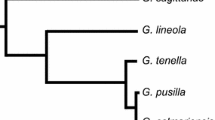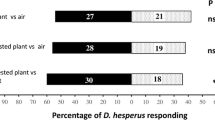Abstract
Mated female cabbage looper months that were caged with cotton, celery, or soybean foliage were attracted significantly more often than inexperienced moths to the odor of the same species of plant the following night. Moths that were caged with cotton or celery foliage were attracted significantly more often the following night only to the foliage of the same species, and not to the foliage of the other plant species. Brief contact by a moth or a single oviposition on plant foliage was sufficient to increase subsequent attraction to plant foliage. This behavior appears to be associative learning of host odor.
Similar content being viewed by others
References
Duncan, D. B. (1955). Multiple range and multiple F tests.Biometrics 11: 1–42.
Guy, R. H., Leppla, N. C., Rye, J. R., Green, C. W., Barette, S. L., and Hollein, K. A. (1985).Trichoplusia ni. In Singh, P., and Moore, R. F. (ed.),Handbook of Insect Rearing, Vol. 2, Elsevier, Amsterdam, pp. 487–494.
Jaenike, J. (1988). Effects of early adult experience on host selection in insects: Some experimental and theoretical results.J. Insect Behav. 1: 3–15.
Lance, D. R. (1983). Host seeking behavior of the gypsy moth: The influence of polyphagy and highly apparent host plants. In Ahmad, S. (ed.),Herbivorous Insect: Host Seeking Behavior and Mechanisms, Academic Press, New York, pp. 210–224.
Landolt, P. J. (1989). Attraction of the cabbage looper to host plant and host plant odor in the laboratory.Entomol. Exp. Appl. 53: 117–124.
Landolt, P. J. (1993). Effects of host plant leaf damage on cabbage looper moth attraction and oviposition.Entomol. Exp. Appl. 67: 79–85.
Landolt, P. J., and Lovvorn, S. (1997). Suitability of plants of north Florida as hosts of larval cabbage loopers,Trichoplusia ni (Hubner) (Lepidoptera: Noctuidae) (submitted for publication).
Lee, J. C., Bernays, E. A., and Wrubel, R. P. (1987). Does learning play a role in host location and selection by grasshoppers? In Labeyrie, V., Fabres, G., and Lachaise, D. (eds.),Insects-Plants, Proceedings 6th International Sympsoium on Insection-Plant Relationships, PAU 1986, Junk Dordrecht, The Netherlands, pp. 125–127.
Miller, J. R., and Strickler, K. L. (1984). Finding and accepting host plants. In Bell, W. J., and Cardé, R. T. (eds.),Chemical Ecology of Insect, Chapman and Hall, pp. 127–157.
Papaj, D. R. (1986). Conditioning of leaf shape discrimination by chemical cues in the butterfly,Battus philenor.Anim. Behav. 34: 1281–1288.
Papaj, D. R., and Prokopy, R. J. (1989). Ecological and evolationary aspects of learning in phytophagous insects.Annu. Rev. Entomol. 34:315–350.
Phelan, P. L., and Baker, T. C. (1987). An attracticide for control ofAmyelois transitella (Lepidoptera: Pyralidae) in almonds.J. Econ. Entomol. 80: 779–783.
Phelan, P. L., Roelofs, C. J., Youngman, R. R., and Baker, T. C. (1991). Characterization of chemicals mediating ovipositional host-plant finding byAmyelois transitella.J. Chem. Ecol. 17: 599–613.
Prokopy, R. J., Drew, R. A. I., Sabine, B. N. E., Lloyd, A. C., and Hanecek, E. (1991). Effect of physiological and experiential state ofBactrocera tryoni flies on intra tree foraging behavior for food (bacteria) and host fruit.Oecologia 87: 394–400.
Saxena, K. N., and Schoonhoven, M. (1978). Induction of orientational and feeding preference inManduca sexta.Entomol. Exp. Appl. 42: 198–200.
Sutherland, D. W. S., and Green, G. L. (1984). Cultivated and wild host plants. In Lingren, P. D., and Greene, G. L. (eds.),Suppression and Management of Cabbage Looper Populations, USDA Tech. Bull. 1684, pp. 1–13.
Tingle, F. C., Health, R. R., and Mitchell, E. R. (1989). Flight response ofHeliothis subflexa (Gn.) females (Lepidoptera: Noctuidae) to an attractant from ground cherry,Physalis angulata L.J. Chem. Ecol. 15: 221–231.
Visser, J. H., and Thiery, D. (1986). Effects of feeding experience on odour-conditioned anemotaxes of Colorado potato beetle.Entomol. Exp. Appl. 42: 198–200.
Author information
Authors and Affiliations
Rights and permissions
About this article
Cite this article
Landolt, P.J., Molina, O. Host-finding by cabbage looper moths (Lepidoptera: Noctuidae): Learning of host odor upon contact with host foliage. J Insect Behav 9, 899–908 (1996). https://doi.org/10.1007/BF02208977
Revised:
Issue Date:
DOI: https://doi.org/10.1007/BF02208977




